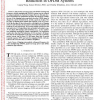8 search results - page 1 / 2 » Cross-Entropy-Based Sign-Selection Algorithms for Peak-to-Av... |
TSP
2008
13 years 4 months ago
2008
Sign-selection uses a set of subcarrier signs to reduce the peak-to-average power ratio (PAR) of orthogonal-frequency-division multiplexing (OFDM). However, the computational compl...
TSP
2008
13 years 4 months ago
2008
The peak-to-average power ratio (PAR) of orthogonal frequency division multiplexing (OFDM) systems can be reduced by using an optimal set of subcarrier signs. However, this sign se...
GLOBECOM
2007
IEEE
13 years 11 months ago
2007
IEEE
—The high peak-to-average power ratio is a major drawback of OFDM systems. Many PAPR reduction techniques have been proposed in the literature, among them a method that uses a su...
ICC
2007
IEEE
13 years 10 months ago
2007
IEEE
— For Orthogonal Frequency-Division Multiplexing (OFDM) systems, Peak to Average Power Ratio (PAPR) can be a major impediment to efficient transmission due to the need to use in...
GLOBECOM
2006
IEEE
13 years 10 months ago
2006
IEEE
— Existing tone-reservation algorithms (such as the controlled clipper algorithm) for OFDM require a number of iterations to ensure the reduction of Peak-to-Average Power Ratio (...

